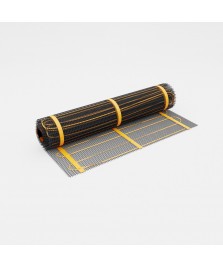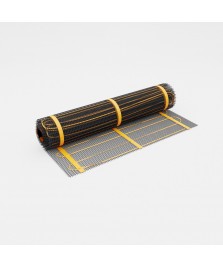- today
- label Accessories
- favorite 2 likes
- remove_red_eye 1834 views

When designing your dream bathroom or wet room, one of the most crucial aspects to consider is heating. A well-heated space not only provides comfort but also helps prevent issues like dampness and mould.
This in-depth guide will explain the various heating options for your wet room to help you make an informed decision.
Understanding Your Wet Room Heating Needs
Before we look at heating options, it's essential to understand the unique requirements of a wet room. Unlike traditional bathrooms, wet rooms are fully waterproof, allowing the whole space to get wet. This open design can present challenges when it comes to heating. One of the biggest concerns is keeping the entire space warm and dry to prevent issues like dampness and mould.
Fortunately, there are several heating options available for your wet room.
Bathroom Radiators: The Traditional Central Heating Choice
When many think of heating bathrooms, radiators often come to mind first. They remain a popular choice for many homeowners looking to heat their bathroom or wet room.
These are the main types of radiators used in bathrooms:
Towel Radiator or Heated Towel Rail
A towel radiator, also known as a heated towel rail, serves the dual purpose of heating the room and warming towels. Heated towel radiators are popular in both traditional and modern bathrooms.
Horizontal Radiator
The classic horizontal radiator is still a popular choice. This type of bathroom radiator is great for larger bathrooms with ample wall space. A horizontal designer radiator can add a touch of elegance to your bathroom suite.
Column Radiator or Traditional Radiator
These traditional-style radiators are making a comeback in modern bathrooms. They offer aesthetic appeal and efficient heating.
Designer Radiator
A designer bathroom radiator can be an attractive option for those looking to make a style statement. These radiators come in various shapes, sizes, and finishes to complement your bathroom decor.
Vertical Radiator
A vertical radiator is an excellent choice for bathrooms with limited wall space. They are both functional and aesthetically pleasing. There are also vertical designer radiator options available to suit various tastes.
Electric Radiator
For those without a central heating system, an electric radiator can be a good alternative. They're easy to install and can be controlled independently.
Choosing the Best Radiator for Bathroom Spaces
When selecting a new radiator for your bathroom, consider the following factors:
-
Heat output: Ensure the radiator provides adequate heat output for your space. This is typically measured in BTUs (British Thermal Units).
-
Size and style: The best radiator for bathrooms fits your available wall and floor space and complements your existing or new bathroom design.
-
Material: Common materials include stainless steel, aluminium, and chrome. Stainless steel and chrome radiators are popular choices, while aluminium radiators offer excellent efficiency.
-
Fuel type: Decide between central heating radiators, electric radiators, or dual fuel radiators.
-
Added radiator features: Look out for radiators with extra features for enhanced convenience. Thermostatic radiator valves or angled radiator valves offer better temperature control.
Limitations of Radiators for Wet Rooms
Radiators are great for providing targeted heat and can be an attractive addition to your bathroom design. However, they may not always be the best choice for wet rooms. They take up wall space, which can be a premium in smaller wet rooms. They may also not provide even heat distribution throughout the space. Additionally, standard radiators are susceptible to rust in a wet room's humid environment.
Underfloor Heating: A Great Option for Wet Rooms
Underfloor heating systems are another excellent heating solution for wet rooms. Here’s why:
-
Underfloor heating provides consistent warmth across the entire floor surface, eliminating cold spots.
-
Unlike radiators, underfloor heating is hidden beneath the floor. This frees up space on the walls and creates a sleek, minimalist look.
-
Underfloor heating systems are typically more energy-efficient than radiators. This can potentially reduce your heating costs.
-
The gentle, radiant heat from the floor creates a comfortable environment. It also helps to dry the floor quickly after use.
-
Underfloor heating works well with various floor finishes, including tiles, stone, and even some types of wood.
Different Types of Bathroom Underfloor Heating
There are two main types of underfloor heating:
Electric Underfloor Heating
This system uses electric wires or heating mats installed beneath the floor. It's affordable and relatively easy to install, especially in smaller areas like wet rooms.
Water-Based Underfloor Heating
This system circulates warm water through pipes under the floor. While more complex to install, it can be more cost-effective to run, especially in larger areas.
Other Bathroom Heating Options for Wet Rooms
While radiators and underfloor heating are the most common choices, there are other options to consider:
-
Infrared heating panels: These slim panels can be mounted on walls or ceilings to provide radiant heat. They're energy-efficient and can be a good option for smaller wet rooms.
-
Fan heaters: While not suitable as a primary heat source, a fan heater can provide quick warmth when needed.
-
Heated mirrors: These serve a dual purpose of preventing mirror fog and providing localised heat to the room.
Choosing the Best Heating for Your Wet Room
When deciding on the best heating solution for your wet room, consider the following:
-
Heat distribution: Underfloor heating provides the most even heat distribution. This is followed by well-placed radiators.
-
Energy efficiency: Underfloor heating is generally more energy-efficient than radiators.
-
Space considerations: Underfloor heating or ceiling-mounted options may be better if wall space is limited.
-
Installation: Consider the complexity of installation, as this will directly impact the costs involved.
-
Aesthetics: Underfloor heating is hidden, while radiators and heating panels can be part of your room's design.
-
Budget: Factor in both initial costs and long-term running costs when making your decision.
Enjoy a Luxurious, Heated Bathroom Experience with Wetroomstop
When it comes to heating your wetroom, underfloor heating stands out as an excellent choice. At Wetroomstop, we offer a range of affordable, high-quality electric underfloor heating systems designed specifically for wet rooms. They’re easy to install, energy-efficient, and provide excellent heat output. Plus, they work well under most flooring types, including tile, bonded wood, and vinyl.
Contact our expert team for more information about our underfloor heating systems and other wet room products. We're always happy to offer advice and product recommendations.












